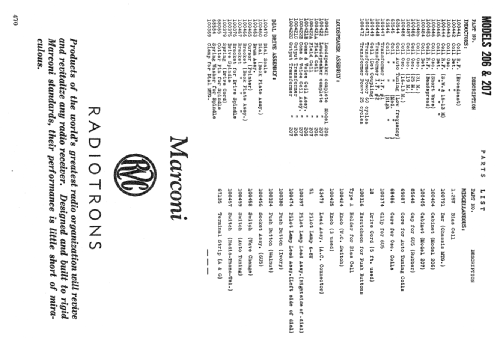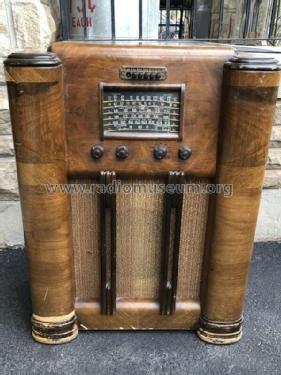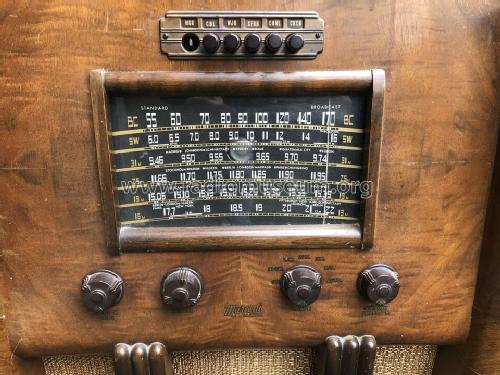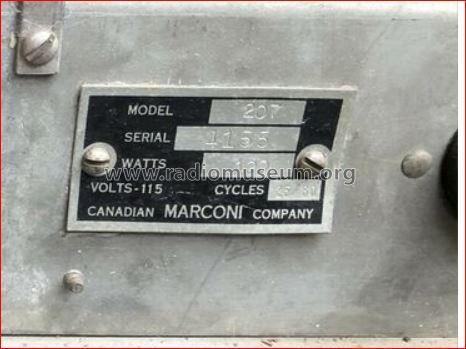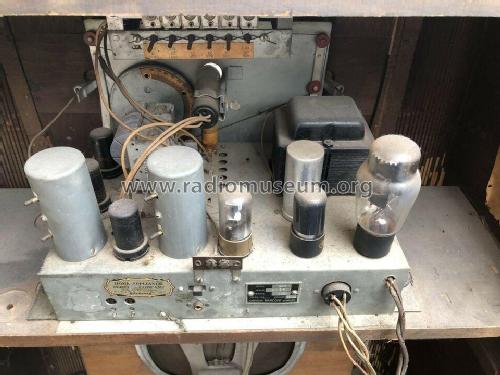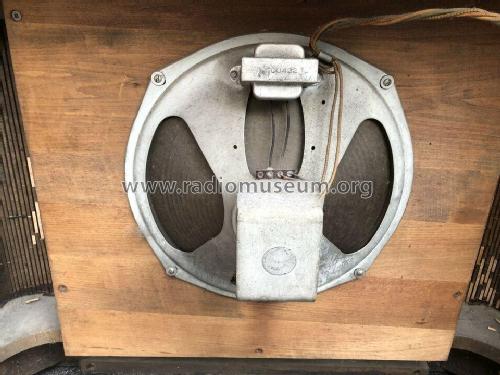- Country
- Canada
- Manufacturer / Brand
- Canadian Marconi Co. Ltd. (CMC, Esterline), Marconi's Wireless; Montreal, QC
- Year
- 1941 ?
- Category
- Broadcast Receiver - or past WW2 Tuner
- Radiomuseum.org ID
- 299007
-
- alternative name: CMC Canada || Marconi, Canada
Click on the schematic thumbnail to request the schematic as a free document.
- Number of Tubes
- 7
- Main principle
- Superhet with RF-stage; ZF/IF 462.5 kHz; 2 AF stage(s)
- Tuned circuits
- 7 AM circuit(s)
- Wave bands
- Broadcast plus more than 2 Short Wave bands.
- Power type and voltage
- Alternating Current supply (AC) / 115 Volt
- Loudspeaker
- Electro Magnetic Dynamic LS (moving-coil with field excitation coil) / Ø 12 inch = 30.5 cm
- Power out
- 3.5 W (8.5 W max.)
- Material
- Wooden case
- from Radiomuseum.org
- Model: 207 - Canadian Marconi Co. Ltd. CMC,
- Shape
- Console with Push Buttons.
- Notes
-
The Canadian Marconi model 206 is a 7-tube console radio with tuning eye tube and pushbutton station selector. Covers the following ranges:
Band Frequency (kHz) Standard Broadcast 540 - 1710 Shortwave 5860-16030 31m 9450 - 9750 25m 11645 - 11965 19m 15050 - 15400 Shortwave 17600 - 22040
- Literature/Schematics (1)
- Marconi Service Manual (Volume 1) (P. 467-470)
- Author
- Model page created by Tom Seeger. See "Data change" for further contributors.
- Other Models
-
Here you find 465 models, 328 with images and 378 with schematics for wireless sets etc. In French: TSF for Télégraphie sans fil.
All listed radios etc. from Canadian Marconi Co. Ltd. (CMC, Esterline), Marconi's Wireless; Montreal, QC
Forum contributions about this model: Canadian Marconi Co.: 207
Threads: 1 | Posts: 2
This is my first renovation, and my first post, so I'm a bit reticent in case I have my finding wrong. But I don't think so!
This is the Marocni 207, electrically identical, I believe, to the 206, and I'm looking at R18 / R19 in parallel, which feed voltage to the screen grids of the first & second stages of the RF path. The components list shows these as 2K6, 2W each, to give a combined value of 1K3 at 4W.
In my restoration of serial no. 4511, the parallel pair shows 40K instead of the advertised 1K3. That's a clue! But the resistors themselves have colour coding for 26K, not 2K6. Looking at the specs for these two valves (sorry, I can't get used to calling them "tubes," even though I now live in Canada), it's clear that a value of 1K3 for the resistor pair just doesn't work. 13K is better.
So I'm postulagting that the components list has the values wrong. Does that make sense? If I get agreement, I'll re-post this as information.
I'm finding that antique radio restoration is a combination of detective work, logic, and hard-earned knowledge. I love it!
Alistair Thomson, 25.Nov.18



